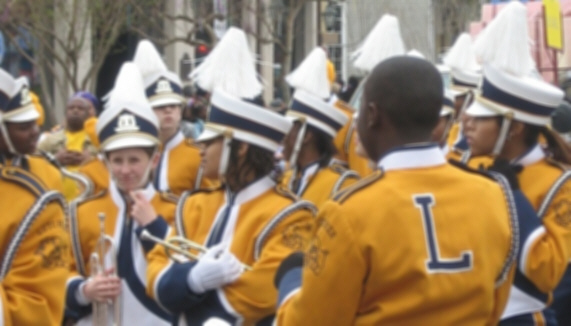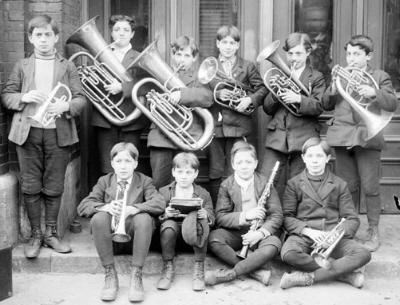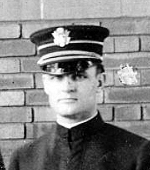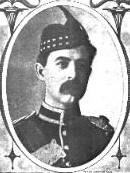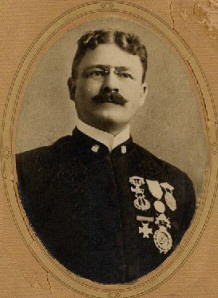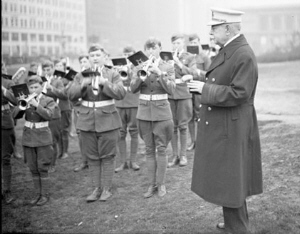9
|
||
Sometimes in history there are those events which, in retrospect, fostered consequences far exceeding what the original instigators ever could have imagined. Such was the case with the Schools Band Contest of America first held in 1923. This first "national" event, sponsored by instrument manufacturers for the sole purpose of boosting sales of band instruments, grew well beyond its original purpose. Over the next decade and beyond it helped bring stability to school band programs that had struggled through a sporadic past, while raising the standards of performance and literature in America's school bands. ORIGINS OF THE SCHOOL BANDSLowell Mason has long been credited with establishing music programs in the public schools of America. His inclusion of singing classes in the curriculum of Boston grammar schools in 1838 was a notable beginning for public music education, but did little for the perpetuation of instrumental music. For the next fifty years vocal music at the secondary school level remained an extracurricular activity and bands and orchestras appeared sporadically at best. Academic programs had little use for artistic subjects. Instead, they emphasized what seemed at the time to be the most practical subject matter. The dramatic urbanization of American society led to a fourfold increase in secondary school enrollments between the years 1885 - 1910. Concurrent with this increase were demands for activities and services not previously provided by public education, such as health centers, child guidance clinics, nursing programs, hot lunch programs, and playgrounds. Interscholastic athletics and military training programs became popular, along with the addition of vocational and citizenship classes. These changes in the social and education norm made it possible for the "Sunday school orchestra" and the "fire house band" to move into the schoolhouse.1 Bands of varying quality were formed to provide high-decibel support for the efforts of the players on the football field, or to provide a musical outlet to boys who could not sing. Band directors usually had no formal training in music education. They were often part-time employees whose main emphasis was professional music, or teachers from other disciplines who claimed to have some knowledge of music. Band programs were formed with an emphasis on social purposes to the exclusion of the aesthetic, so school band instrumentation was inconsistent, and the quality of music was usually low, consisting mainly of marches, waltzes, two-steps, "smears," and ragtime.2 - Back to Top -SCHOOL BANDS OF THE EARLY TWENTIETH CENTURYToward the end of World War I the quality of bands began to take an upswing when veterans, trained in the service bands, began to accept music teaching positions. A few Midwestern states that held state music contests began to expand these events to include bands. However, band was still an extracurricular activity, while vocal music was increasingly included in the secondary education curriculum. After its organization in 1907, the Music Supervisors National Conference (later to be renamed the Music Educators National Conference) studied the possibility of securing academic credit for music classes in the secondary schools. In 1912 accreditation was proposed for music activities in the following order: chorus, music appreciation, girls' chorus, band, and boys' chorus or glee club. Band was not a high priority, and it continued to struggle for several more years for any sense of equality with other music ensembles.3 But change was inevitable, as expressed by Edgar B. Gordon, addressing a number of supervisors at a sectional meeting of the MSNC in 1923 in Cleveland: The high school band is no longer an incidental school enterprise prompted largely by the volunteer services of a high school teacher who happens to have had some band experience, but rather an undertaking which is assigned to a definite place in the school schedule with a daily class period under a trained instructor and with credit allowed for satisfactory work done.4 School band programs gradually began to enjoy more acceptance even as a rapid decline in professional and amateur bands was taking place. - Back to Top -DECLINE IN PROFESSIONAL BANDSLooking back to 1890, it is estimated that as many as 10,000 bands were active in the United States, interest having been stimulated by the popularity of the professional bands. In 1915 Albert Austin Harding reported that at one time the state of Illinois had more bands than towns. Bands were found in schools, universities, factories, department stores, churches, amusement parks, prisons, seminaries, and schools for the feeble-minded. Most were small, but a few boasted over 100 musicians. Unfortunately, this phenomenon could not sustain itself. Emil A. Holz describes the ensuing situation: These thousands of bands provided music for parades, civic ceremonials, concerts, and dances. As the popularity of Sousa and the other great bandleaders increased, a host of imitators appeared. The intense competition that developed led to price-cutting and charlatanism. As quality deteriorated the attraction of the town or park band waned. By 1920 many had succumbed under the simultaneous attacks of jazz, the automobile, the moving picture, and the phonograph. The great concert bands ceased touring and village bandstands stood deserted.5 - Back to Top -THE FIRST NATIONAL SCHOOL BAND CONTESTEconomics of InstrumentsCuriously, one source of support for the sale of band instruments came from a voluntary levy of fifty cents on every piano manufactured and sold in the United States. Eventually piano manufacturers came to object to the promotion and sale of band instruments, feeling the decline of piano sales was due to the increased interest in school bands. They later realized part of their problem was fostered by the slogan "Don't learn to play the piano...buy one that plays itself." Also, the radio and phonograph had become more popular means of entertainment, sending sales of the player piano into a rapid decline.1The aforementioned social climate of the 1920's and the end of World War I brought about a decline in both professional and military bands. The band instrument industry was in desperate need of a new market for instrument sales. With school band programs on the rise, and music supervisors becoming more accepting of band programs in the curricula, the manufacturers began to build a new market base. In 1923 the Chicago Piano Club, a dealer's association, searched for entertainment for the annual convention of the Music Industries Chamber of Commerce, an association of manufacturers, publishers, and dealers scheduled to meet in Chicago on June 3 - 7 of the same year. Victor J. Grabel, then director of the band at the Cicero plant of the Western Electric Company, provided the suggestion of a band contest. The Piano Club enthusiastically suggested to Carl D. Greenleaf (president of C. G. Conn, Ltd.) that the band instrument makers should organize and plan the project. Consequently, 10,000 dollars was raised to fund the project. The preliminary announcement, mailed out in early April, received a response from thirty bands, fifteen coming from the Chicago area alone. No doubt the short turnaround time made it impossible for many schools to make an affirmative response. Patrick Henry, contest organizer, capitalized on the presence of a few girls, the extreme youth of some participants, the element of jazz, and the entrance of a band of African-Americans, as propaganda to promote the industry objectives - music for everyone and "jazzier jazz bands."6 - Back to Top -Frustrations EnsueThe contest was poorly run for a variety of reasons. Accommodations were limited as the boys slept in a barracks-like room on the Navy Pier on army cots. Also, the performance setting left much to be desired. The competition was conducted outdoors in Grant Park on a temporary bandstand located between Michigan Avenue and the tracks of the Illinois Central Railroad. While contending with the noises of avenue traffic, the railroad yard, and competing bands warming up, each band competed before the single judge, Lieutenant William H. Santelmann, director of the United States Marine Corps Band. Since three judges had been promised, employing a single judge provoked criticism from several directors who were used to the advantages provided by group appraisal. Further criticism concerned the disparity between the advertised standards and those employed by Lieutenant Santelmann. Since no required music list was employed, directors had worked up whatever music was readily at their disposal given the short time of six to seven weeks between the first written notice and the contest date.7 Also, there were no standards concerning the size or instrumentation of groups. The band from Fostoria, Ohio directed by John W. Wainwright won the first contest. - Back to Top -Plans for ContinuationDespite the numerous problems and frustrations surrounding the inaugural contest, there was also enough enthusiasm generated to suggest it be continued under the sponsorship of the band instrument makers. Ensuing conversations carried the idea a step further. The manufacturers agreed to provide funds for the event and music educators agreed to establish and enforce all regulations for entrance, repertoire, adjudication, and performance, under the auspices of the Music Supervisors National Conference. Sponsorship passed to the Committee on Instrumental Affairs of the Music Supervisors National Conference and the National Bureau of the Advancement of Music, headed by Charles M. Tremaine. NBAM was an organization supported by the music industry to promote a variety of musical events. The objectives of the Committee on Instrumental Affairs and the NBAM were to increase the number of school bands and to elevate their quality of performance. Their goal was to enhance the quality of performance by requiring better music for the bands to play. A repertoire list was introduced which included symphonic movements, suites, overtures, and symphonic poems. They also worked to set a standard instrumentation requiring a balance between brass and woodwinds, including the addition of horn, oboe, and bassoon. In 1924-25 most bands could not meet the new standards, so the Committee on Instrumental Affairs and the NBAM focused on developing state contests which provided directors time to develop better bands, all of which served as a springboard for the next national contest. It was also agreed that the whole country would be represented in a "national" contest, so elimination contests were held in several states prior to the five regional contests to determine the participants in the next national event. - Back to Top -THE 1926 CONTESTBy 1926, with fifteen states boasting state contests, it was decided to hold another national contest. The 1926 contest was held in Fostoria, Ohio, hosted by John W. Wainwright, the director who had won the first contest. Wainwright received significant community support for the event with committees formed to deal with transportation, housing, meals, auditorium seating, decorations, and finances. Merchants bought up a sizable number of tickets to the events, guaranteeing financial success. In fact the band boosters enjoyed a $700 profit when the contest was concluded.8 The 1926 contest took place on June 4 and 5, with thirteen bands in attendance. The judges were Joseph E. Maddy of the University of Michigan, Lieutenant William C. White, commander of the Army Bandmasters' Training School in Washington, D. C. and William C. Robinson, director of the Royal Kilties Regimental Band in Hamilton, Ontario. Each band played the required Prelude from Bizet's L'Arlesienne, one selection freely chosen from the list prepared by the Committee on Instrumental Affairs, and a march. The Joliet, Illinois band under the direction of A. R. McAllister received first place with a score of 92.6%, with Fostoria pacing second, scoring 92%. - Back to Top -THE 1927 CONTESTLee M. Lockhart of Council Bluffs, Iowa Bluffs organized the 1927 contest. With more states holding preliminary state contests, the next national contest had a total of twenty-three bands, almost double the previous effort. For the first time bands were divided into Class A (schools with enrollments of more than 250 students) and Class B (schools with enrollments less than 250) competition. Compulsory sight-reading was also introduced. Judges for this contest were Herbert L. Clarke (cornet soloist and director of the Long Beach Municipal Band), Captain Taylor Branson (director of the United States Marine Band), Osbourne McConathy, and Joseph E. Maddy. McConathy had a long association with school music, and at the time, was editing music for the Silver Burdett Company. The required piece was "Huldingungsmarsh" from Grieg's Jorsalfar, and the sight-reading was Harry Alford's Nero the Burning of Rome. The audience stood in tribute as the Joliet band, the 1926 champions, took the stage. The hometown Council Bluffs band and its director, Lee M. Lockhart, enjoyed a five-minute plus ovation upon their appearance. But Joliet won again with a score of 93.38%, with Council Bluffs taking second with a score of 93.31%. Princeton, California took first place in Class B.9 - Back to Top -THE 1928 CONTESTIn 1928 the National Contest was held amidst much anticipation. Joliet was already two time national champions, and, by contest rules, a third victory would place them in permanent possession of the first-place trophy. Joliet was also the host city for the competition, which meant a victory by the host band would allow them to retire the trophy on home ground. The 1928 contest was the first of three judged by the celebrated John Philip Sousa. The other judges were Edwin Franco Goldman, director of the Goldman Band, and Captain Charles O'Neill, a graduate of the Royal Military School of Music in London, who was director of the Royal Twenty-Second Regimental Band of Quebec. Joseph E. Maddy judged sight-reading. Eleven of the twenty-seven bands participating were in Class B, increasing the importance of this aspect of the National Contest. In 1928, for the first time, there were separate required pieces: Sibelius' Finlandia for the Class A bands, and Justin Elie's Queen of the Night for class B. The Class A finals lasted until nearly midnight, with the judging pushing the announcement even later. Joliet won with a score of 95.81%, a victory which set off honking horns, sirens, blank pistol shots, and fireworks in celebration.10 - Back to Top -STANDARD INSTRUMENTATIONT year 1928 also saw the standardization of instrumentation. The 1926 contest had allowed judges to subjectively score what constituted a good instrumentation. In 1927 the Committee on Instrumental Affairs adopted an instrumentation for a sixty-eight piece band as suggested by Maddy in a 1925 booklet, School Bands: How They May Be Developed, published by the NBAM. Maddy's instrumentation was influenced by Sousa's 1924 band of seventy-five pieces, and required alto and bass clarinets, a bass saxophone, the substitution of horns for alto horns, and the addition of fluegelhorns to the cornet and trumpet sections. In 1928 standardized instrumentation was set at seventy-two players upon the recommendation of a committee which included Sousa, Frederick Stock, Edwin Franco Goldman, Captain Taylor Branson, and Herbert L. Clarke. Any instrument lacking in a section resulted in a half-point penalty. Over-instrumentation was not penalized, per se, other than aspects regarding quality of performance.11 - Back to Top -THE 1929 CONTESTAs the contest size grew, it was decided that it was necessary to hold the event in larger cities that could more adequately sustain the venue. As a result, the 1929 contest was held in Denver, Colorado. Twenty-six bands participated, and for the first time the Class B bands outnumbered the Class A bands fifteen to eleven. Despite the geographical change, the mid-west bands still held the upper hand with Senn High School of Chicago winning the Class A division and Boys Vocational School of Lansing, Michigan winning the Class B. King Stacy directed the latter band which was a correctional facility for boys between the ages of twelve and seventeen. Senn High School narrowly beat out a band from Modesto, California by four tenths of a percentage point. Indeed the margin of victory for the National Contest was typically very narrow, creating a very intense atmosphere. Leonard Falcone noted in a letter dated December 20, 1966: The difference between the first, second, third, and fourth in the contest days was very little, but the disappointment of not receiving first place was most discouraging to the students, conductors, and the people back home. Feelings were aired that contests had become too competitive, to the detriment of the initial desire to improve musicianship in concert bands. One option to the contests was to hold festivals where groups came together to play for one another as well as an audience. Comments would be given and all would appear in a mass performance, but the groups would not necessarily be in competition with one another. Another option was a grading system in which multiple bands could potentially receive a Division I rating without a clear winner, thus decreasing the amount of rivalry generated between competing bands.12 THE 1930 AND 1931 CONTESTS- Back to Top -The 1930 contest was held in Flint, Michigan with forty-four bands in competition--this despite the ongoing depression. Class C competition was introduced for the first time in the national competition, indicating the band movement had successfully spread to even smaller schools across the country. Senn won for the second year in a row, with a score of 94.8%, narrowly beating out Joliet, who could now compete after a year of ineligibility, who scored a 94.5%. In fact, a score of only one percentage point separated the first four bands. Hobart High School and William RevelliThe winner of the 1930 and 1931 Class B division was the high school band from Hobart, Indiana under the direction of William Revelli. Like Sousa, Revelli's primary instrument was the violin. He went on to further distinguish himself as the director of bands at the University of Michigan where he became one of the most celebrated band conductors of the twentieth century.The 1931 contest was held in Tulsa, Oklahoma, and marked the last year that an outright winner would be awarded. Joliet recaptured the Class A first place. As typical of all national contests, the last day included a parade and massed band concert. In Tulsa, seventy seven year old John Philip Sousa conducted the concert at Skelly Stadium on the campus of the University of Tulsa. Under his baton the masses band performed The Southerner by Russell Alexander, a march by E. E. Bagley, as well as Sousa's own U.S. Field Artillery March and The Stars and Stripes Forever. He died less than a year later.13 - Back to Top -SUBSEQUENT CONTESTS AND THE BEGINNING OF THE ENDPlans were in place to have the next contest in Des Moines, Iowa, but political and economic events of the depression caused the event to be canceled. When the event resumed in 1933 divisional ratings were introduced, changing the competitive climate of the event significantly. For the subsequent contests held through 1931 there was an individual winner, whereas in later years this practice was discontinued in favor of a system where ratings by numbers were issued, ranging from excellent to poor. By using this system, there was the possibility of having several first divisions awarded.14 The contests had done an extraordinarily good job of raising the quality of school bands. The performance level of the bands and quality of literature performed had improved. But concerns began to be voiced as to the overall benefit of the contests. First, there was the aforementioned concern about the intense rivalry leading to one overall winner. Also, school officials questioned the travel expense involved during a time of depression, as well as the interruption of class routine. The educational value of focusing long periods of time on a very limited repertory also came into question. It came down to a simple evaluation of whether the problems resulting in preparation and expense to perform at the national contest could be justified educationally and financially. No doubt echoing their sentiments were the increasing number of band directors who swelled the ranks of the loser category in the contests. The national contest in 1933 was held in Evanston, Illinois. The 1934 and 1936 contests were held in Des Moines, Iowa and Cleveland, Ohio, respectively. By 1938, it was perceived that the national contest had become too large to manage, so regional contests were sponsored, instead. In time, state run contests would become the dominant force, and have remained so to the present. - Back to Top -CONCLUSIONThe national school band contests helped to stimulate the establishment of schools for band directors, college curricula for instrumental teachers, and dialogue on how to improve standards of performance. Although a national contest no longer exists, the momentum it sparked has carried on to this day through the spirit of competition and high standards of performance found in contemporary school bands. - Back to Top -
|
||
